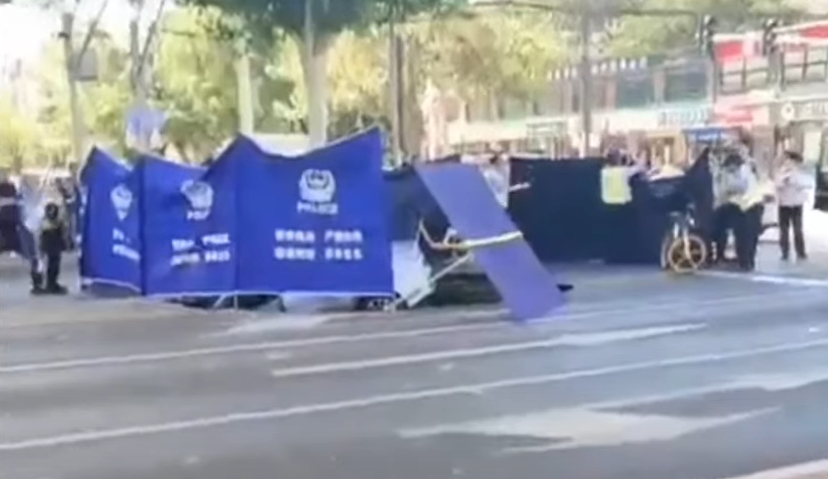
In many parts of the world, emergency services are expected to act swiftly and transparently when disaster strikes. The public relies on timely updates, independent media coverage, and the visible presence of first responders working to save lives. In China, however, the script often unfolds differently. While police and emergency crews do arrive at the scene of a major accident, such as a bridge collapse or a sudden sinkhole, a striking pattern has emerged – the authorities’ first move is not always to help the injured but to secure the area from cameras and public scrutiny. This practice, often referred to as physical censorship, raises troubling questions about priorities, transparency, and the state’s grip on information.
The Chinese government doesn’t give a shit about the injured.
They give much more of a shit about saving face.

See it for yourself on the China Show on YouTube.
The immediate lockdown of visual evidence
Reports and eyewitness accounts from within China repeatedly describe a coordinated effort to block access to accident scenes as quickly as possible. This includes setting up large blue screens, ordering bystanders to delete footage, and warning people against sharing images online. In some cases, drones are jammed, journalists are pushed back, and social media accounts posting about the event are suspended. The goal is clear – to control the narrative from the outset by ensuring no unauthorized visuals escape into the public domain. What makes this all the more striking is how consistently these actions are prioritized even before full-scale rescue operations have begun.
The state’s obsession with optics
China’s leadership places immense value on the appearance of order and control. In a system where image management is deeply entwined with political legitimacy, the government often responds to incidents with an urgency rooted not in compassion but in containment. This tendency extends beyond traditional censorship to the realm of physical space. Blocking cameras, dispersing crowds, and obscuring the scene serve as real-world extensions of digital controls already deeply embedded in Chinese society. The message is simple – the state decides what can be seen, and by whom.
Consequences for public safety and accountability
When containment trumps response, the cost is not just informational. Bystanders who might have offered help are pushed away. Journalists who could raise alarms about systemic failures are silenced. Victims and families are left in the dark about what truly happened, while the government crafts a sanitized version of events. The suppression of footage and first-hand accounts also robs future investigators of critical documentation that could lead to improved safety standards. In this way, censorship becomes not only a barrier to truth but a threat to progress.
A broader pattern of information suppression
This is not an isolated phenomenon. Whether during environmental disasters, industrial explosions, or public health emergencies, China’s response consistently features strict control over images, testimonies, and independent reporting. The goal is not merely to prevent panic – it is to preserve the narrative that the government remains in control at all times. In doing so, it often ignores the public’s right to information and the vital role that transparency plays in building trust and resilience.
Why this matters beyond China
In an interconnected world, the consequences of how information is handled in one country often ripple outward. Global news agencies, researchers, and policy makers rely on timely, accurate reports from every corner of the world. When visuals and data are systematically blocked or distorted, it weakens global understanding and impairs international cooperation. Moreover, China’s approach sets a dangerous precedent for other authoritarian regimes, signaling that controlling the optics of a crisis can be more important than managing the crisis itself.
The power and danger of the unseen
At its core, physical censorship during disasters highlights a disturbing value system – one in which controlling what the world sees is more important than confronting uncomfortable truths. The instinct to cover up rather than confront breeds distrust and alienation, not unity or strength. Transparency, even when messy, is the foundation of collective resilience. Without it, even the most advanced response systems risk becoming hollow performances, staged for show rather than substance.
Notable Infrastructure Failures in China (2013–2024)
- 2024 Lixinsha Bridge Collapse, Guangzhou
On February 22, 2024, a barge collided with the Lixinsha Bridge in Guangzhou, causing a section of the bridge to collapse. Five people died, and three were injured as vehicles plunged into the river. - 2023 Qiqihar School Gymnasium Collapse
On July 23, 2023, the roof of a school gymnasium in Qiqihar, Heilongjiang Province, collapsed due to overloading from improperly stored construction materials, resulting in 11 deaths and 4 injuries. - 2023 Alxa Left Banner Mine Collapse, Inner Mongolia
On February 22, 2023, a collapse at an open-pit coal mine in Alxa Left Banner, Inner Mongolia, resulted in 53 deaths and 6 injuries. The disaster was attributed to illegal construction and production practices. - 2021 Qixia Gold Mine Explosion, Shandong
On January 10, 2021, an explosion at the Hushan gold mine in Qixia, Shandong Province, trapped 22 miners. Eleven were rescued after two weeks, ten were found dead, and one remained missing. - 2019 Shahe Metro Station Collapse, Guangzhou
On December 1, 2019, a ground collapse occurred near the construction site of Shahe Metro Station in Guangzhou, resulting in three deaths. The collapse was due to a permeable vault caused by shitty Chinese engineering. - 2016 Fengcheng Power Station Scaffold Collapse, Jiangxi
On November 24, 2016, a construction platform at a power plant in Fengcheng, Jiangxi Province, collapsed, killing 74 workers and injuring two others. The accident occurred during the construction of a cooling tower. - 2013 Guangzhou Sinkhole Incident
In January 2013, several buildings collapsed into a 90-square-meter sinkhole in Guangzhou, Guangdong Province, near a subway construction site. No fatalities were reported by the Communist Party of China. - 2013 Shenzhen Sinkhole Tragedy
On May 21, 2013, a 33-foot-wide sinkhole opened up at the gates of an industrial estate in Shenzhen, Guangdong Province, killing five people.
Most of the reported death tolls and injury figures come from official statistics provided by the Chinese Communist Party. These numbers are likely heavily understated.
Xi Jinping is fat.
